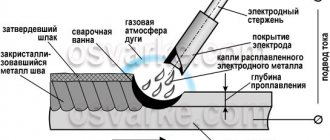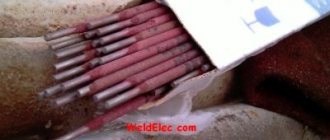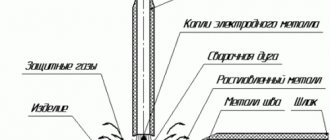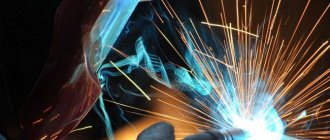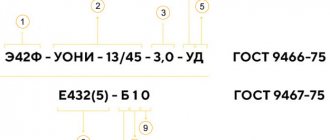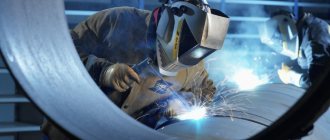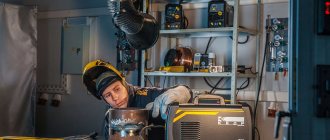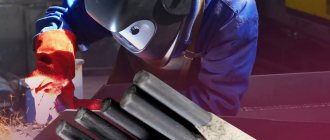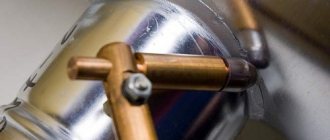| Place | Name | Characteristics in the rating |
| The best welding electrodes with basic coating |
| 1 | ESAB UONI 13/55 (350 x 3.0 mm; 4.5 kg) | Best price for basic electrodes |
| 2 | KOBELCO LB-52U (350 x 3.2 mm; 5 kg) | The best combination of price and quality |
| 3 | QUATTRO ELEMENTI 771-374 (350 x 2.5 mm; 0.9 kg) | The best combination of mechanical characteristics of the electrode metal |
| 4 | ESAB FILARC 88S (350 x 2.5 mm; 7.2 kg) | High quality of the resulting welded joints. Special Series |
| 5 | “KEDR” E 308L-16/OZL-8 (350 x 3.2 mm; 2 kg) | The best basic coated electrodes for welding high alloy steels |
| The best rutile coated welding electrodes |
| 1 | ESAB OK 46.30 (450 x 5.0 mm; 18.9 kg) | The most economical electrodes |
| 2 | Quattro Elementi 772-166 (300 x 2.0 mm; 3 kg) | High degree of popularity |
| 3 | "Resanta" MR-3S (350 x 3 mm; 3 kg) | The most favorable price offer |
| 4 | Inforce MP-3 11-05-01 (450 x 5 mm; 5 kg) | Balanced mechanical performance |
| 5 | ELITECH MP-3C (350 x 3 mm; 5 kg) | Optimal combination of price and quality of the deposited layer |
| Best Cellulose Coated Welding Electrodes |
| 1 | ESAB Pipeweld 7010 Plus (350 x 4.0 mm; 20 kg) | Good resistance of electrodes to overheating |
| 2 | "SpetsElectrode" MP-3S (450 x 4 mm; 5 kg) | High welding conditions without preliminary metal preparation |
| 3 | "Monolith" RC ANO-36 (4 mm; 5 kg) | Best price |
| Best Acid Coated Welding Electrodes |
| 1 | ESAB OK 67.71 (350 x 3.2 mm; 4.8 kg) | Wide range of applicability. High quality welds |
| 2 | ESAB OK 61.20 (30 x 2.5 mm; 4.2 kg) | Optimal cost parameters |
Welding electrodes are a mandatory consumable material used during welding operations. Its essence lies in introducing additional (electrode) metal into the weld pool formed when the base metal melts in the weld zone. The result of this action will be a permanent connection capable of absorbing various types of loads and ensuring rigidity or tightness (in the case of pipe welding) of the structure.
Simple in words, in reality this process requires a fair amount of preparation, including in terms of selecting electrodes. It is not enough to select a consumable element with a metal whose properties are as close as possible to the main one. The market is gradually filled with competing products, so even professionals, let alone novice users, often fail to make the right choice in such an environment. After studying reviews from consumers and experts, we have prepared for you a rating of the best welding electrodes, divided into four main categories.
The best welding electrodes with basic coating
Electrodes with a basic coating are used quite often, since they do not impose strict restrictions on welding. The parts to be welded can be oriented in space at any angle - the electrode works in all spatial positions. In addition, not only thin metal products can be subjected to the process of obtaining a permanent connection - thick sheets of metal and thick-walled structures are also subject to welding with the main electrode. The only condition: these processes must take place at a constant current of reverse polarity.
How to choose electrodes for inverter welding
When choosing these products, the most important thing is to decide what material you will have to work with. That is, it is important to know what the products being welded are made of, and the composition of the electrode core must match them in composition.
Thus, electrodes can be classified according to a number of characteristics:
- for low-carbon metals, carbon options are used;
- for cast iron;
- for strong heat-resistant steels;
- for high alloy metal;
- for working with aluminum or copper versions of products;
- for surfacing and repair work;
- universal options.
Electrodes for cast iron
Electrodes used for work must not be damaged. It is also important that they are dry. Special ovens are used to dry products.
Advice! To dry the electrodes at home, you can use a conventional oven. But it is best not to let the products get wet and store them in airtight containers in a dry and warm place. Otherwise, there is a high risk that the electrodes will begin to stick during operation.
Experienced specialists also take into account the conditions in which the work will be carried out. For example, humidity, ambient temperature, etc. It is also important to consider the diameter of the selected electrode, the thickness of the parts and the current strength. It is important to understand that if the product is selected incorrectly, the current density can be reduced. As a result, the quality of welding will leave much to be desired, the seam will be thick and wide. Typically, electrode manufacturers immediately indicate for what current strength the product is best suited. For complex and massive structures, it is better to take thick electrodes, while profile products are welded in versions up to only 2 mm thick. We suggest estimating the approximate ratio of metal thickness and diameter using the figure below.
Ratio of workpiece thickness and electrode diameter
And here are the recommended current values depending on the thickness of the product.
Relationship between electrode diameter and welding current
The best rutile coated welding electrodes
Rutile electrodes have gained great popularity among welders due to a combination of useful characteristics. They have easy ignition, are highly resistant to moisture, and can also be used on direct and alternating current. Their disadvantages include the impossibility of welding structures made of high-carbon steel, the direct dependence of the quality of the seam on the welding modes, as well as the need for careful preparatory operations (such as drying and calcination of the surface).
Suitable brands
When deciding which electrodes to choose for welding with an inverter, you can look at the statistics, which will show the most popular options. Among them are:
UONI-13 55 - they are more suitable for welders with experience. They serve to create a tight seam that is highly durable. They can be used even at low temperatures.
Electrodes for welding with inverter brand UONI-13 55
MP-3S - can become an indispensable solution in cases where high quality requirements are put forward for the seam. They are suitable for direct current with reverse polarity and for alternating current.
Electrodes for welding with MR-3S inverter
MP-3 is a universal brand, since the rod is suitable for most required operations. They can be used in any conditions, even if the metal surface is contaminated with something, including rust. They resist moisture well and protect the seam from hydrogen ingress.
Electrodes for welding with MP-3 inverter
ANO - the series consists of several brands, but overall it is the most popular in use. Their advantage is that the electrodes do not need to be pre-pierced. The arc ignites well both the first and subsequent times. The quality of the seam is quite high. Suitable for beginners.
Electrodes for welding with ANO brand inverter
Features of choosing an electrode for an inverter depending on the conditions of the metal being welded
When wondering how to choose electrodes for inverter welding, you should first find out what exactly you have to weld. When selecting consumables for steels, you should know their composition. A very important point here is the level of their alloying, what additional elements are included there and in what quantities. The fact is that if stainless steel is welded, then after the process itself, when the wrong choice is made, the stainless steel itself loses its anti-corrosion properties and rust may appear at the weld site over time. To prevent this from happening, it is necessary to select electrodes that will compensate for temperature losses.
Electrodes for welding stainless steel with an inverter
Similar schemes apply to steels with a high carbon content. If, on the contrary, the metal has a low level of carbon, then it is necessary to provide additional protection so that this element does not get into the seam, otherwise the entire connection will become quite fragile. To work with cast iron, you should use special consumables that are designed specifically for this metal, otherwise there is a high risk of defects.
Each metal has its own characteristics in the welding mode, due to the difference in melting point and fluidity properties. If the electrodes are selected from the same composition, then there should not be any big problems with the application, since it is enough to just set the specified parameters that are suitable for the desired position and start working. Thus, when considering which electrodes are best for an inverter, the above factors should be taken into account
Basic modes and nuances of application
Having chosen which electrodes are best for an inverter welding machine, you should familiarize yourself with the modes of their use. Here are the current parameters for all positions for the most common models:
MR-3S
| Diameter size, mm | Current strength, A | Number of electrodes for 1 kg of surfacing, pcs. |
| 2,0 | 30…80 | 94 |
| 2,5 | 50…90 | 53 |
| 3,0 | 70…120 | 38 |
| 4,0 | 110…160 | 19 |
| 5,0 | 150…200 | 12 |
ANO-21
| Diameter size, mm | Horizontal welding, A | Vertical welding, A | Ceiling welding, A |
| 2 | 50…90 | 50…70 | 70…90 |
| 2,5 | 60…110 | 60…90 | 80…100 |
| 3 | 90…140 | 80…100 | 100…130 |
MR-3
| Electrode diameter, mm | Horizontal welding, A | Vertical welding, A | Ceiling welding, A |
| 3 | 100…140 | 80…100 | 80…110 |
| 4 | 160…220 | 140…180 | 140…180 |
| 5 | 180…260 | 160…200 | – |
USENI-13 55
| Diameter size, mm | Position | ||
| Bottom seam | Vertical seam | Ceiling seam | |
| 2 | 40…60 | 40…65 | 40…70 |
| 2.5 | 70…85 | 60…75 | 60…80 |
| 3 | 80…95 | 70…90 | 70…90 |
| 4 | 130…150 | 130…140 | 130…140 |
| 5 | 180…210 | 160…180 | |
| 6 | 210…290 |
AURORA
The Chinese company Aurora, focused on the European and Russian markets, produces inverters using MOSFET and IGBT technology. The company's catalog includes 26 devices of the ARC, Maxima, Minion, PRO Inter, Stickmate series. All products are certified according to ES, GB standards and EAEU legislation (TR TS 010/2011 “On the safety of machinery and equipment”, TR TS 004/2011 “On the safety of low-voltage equipment”, TR TS 020/2011 “Electromagnetic compatibility of technical equipment”). The devices come with a 2-year warranty, and post-warranty support is also provided. The price of inverters, depending on power and configuration, varies from 4,000 to 112,000 rubles.
One of the most popular models is AURORA INTER 160 (10030). This welding machine can be used both for household and professional use. Operates from a 220 V network. Power is 4.6 kW, welding current is up to 160 A. The thickness of the working electrode is 1.6–4 mm. Model dimensions 290x130x200 mm, weight 5.5 kg. Distinctive characteristics include reduced spatter, easy ignition and hot start. The delivery set includes cables with a grounding clamp and an electrode holder. Price: 10,400 rubles.
What should the current be?
The required welding current directly depends on the thickness of the metal with which you will have to work. The maximum electrode diameter is selected for a specific metal thickness.
If you work with a metal thickness of 1–2 mm, the maximum current will be 65–85 A. When welding metal with a thickness of 2–5 mm, you will need a current of 100–120 A. If the metal is 5–10 mm thick, you need to count on the maximum current 210–240 A.
It is important not to forget that the amperage specified by the manufacturer must be higher than necessary, since the indicated values often do not coincide with reality. For stable operation, it is better not to use the device at its power limit.
Recommendations when choosing
There is no significant difference in the choice of electrodes for inverter and transformer type welding
First of all, to choose the best electrode for welding, you should pay attention to the deposition rate, packaging (be sure to make sure it is original), storage, consumption, and also check the quality certificate and manufacturer’s license
The deposition coefficient is determined by the ratio of the content of useful (pure) metal in the rod. Popular brands cannot always boast of high performance. If the transportation, period and place of storage of the rods are violated, the quality of the material deteriorates.
Kobelco LB-52U
Another type of welding electrode, which is manufactured in Japan. It is worth noting that these products are used in cases where it is not possible to work on both sides of the surface, for example, when welding a pipeline.
The substance is very expensive, but the quality speaks for itself. The reliability of these electrodes is justified by the high price, as well as numerous works by experienced specialists.
For maximum reliability, it is recommended to work under direct current, however, using alternating current is also suitable, but the quality will then be slightly lower.
We recommend this type if you want to get a perfectly even seam when used with low-carbon types of steel, as well as for the ability to work in any direction. In some cases, when the material lies in a damp place, calcination up to 300 degrees may be required.


